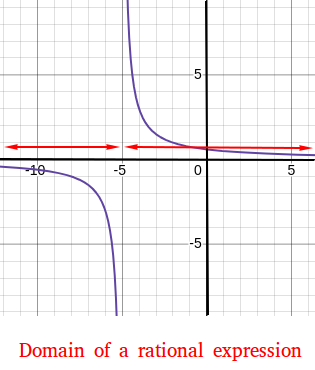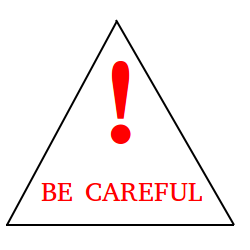What is domain of a rational expression? Definition and examples
The domain of a rational expression is the set of all real numbers for which the rational expression is defined.
Notice that division by zero is not defined. Therefore, any number that makes the denominator equal to zero is not in the domain of a rational expression.
 Graph and domain of 3 / (x + 5)
Graph and domain of 3 / (x + 5)How to find the domain of a rational expression
For example, what is the domain of 3 / (x + 5)? The denominator is x + 5.
To find which number makes the denominator equal to zero, make x + 5 equal to zero and then solve for x.
x + 5 = 0
Subtract 5 from both sides of the equation
x + 5 - 5 = 0 - 5
x + 0 = -5
x = -5
Since x + 5 is equal to zero when x = -5, the domain of 3 / (x + 5) is the set of all real numbers except -5. The domain of 3 / (x + 5) is shown in the graph above with two red lines. We use a small green circle to show that -5 is not included in the domain.

Notice that a number in the domain of 3 / (x + 5) could be equal to something as close to -5 as -5.0001 or -4.9998.
As long as it is not equal to -5, you are free to pick any number!
How to describe the domain of a rational expression using set-builder notation and interval notation
1.
Set-builder notation
Using the set-builder notation to write the domain of 3 / (x + 5 ), we can write "The set of all real numbers x such that x is not equal to -5" as
{x | x is a real number and x ≠ - 5} or simply {x | x ≠ - 5}.
2.
Interval notation
Using the interval notation to write the domain of 3 / (x + 5 ).
We can write (-∞, -5) ∪ (-5, ∞)
Learn more about interval notation.
More examples showing how to find the domain of a rational expression
Example #1
What is the domain of (x - 2) / 9 ?
Which number makes the denominator equal to zero?
The denominator is 9 and 9 will never be zero. Therefore, there are no numbers that will make the denominators equal to 0.
The domain of (x - 2) / 9 is all real numbers.
Example #2
What is the domain of (x2 - 5) / (x + 3)(x - 6) ?
The denominator is (x + 3)(x - 6) and it is equal to zero if (x + 3)(x - 6) = 0
The factor x + 3 is equal to 0 when x = -3 and the factor x - 6 = 0 when x = 6.
The domain of (x2 - 5) / (x + 3)(x - 6) is the set of all real numbers except -3 and 6.
Using the set-builder notation to write the domain of (x2 - 5) / (x + 3)(x - 6), we can write the following:
{x | x is a real number and x ≠ - 3 and x ≠ 6} or simply {x | x ≠ - 3 and x ≠ 6}.
Using the interval notation to write the domain of (x2 - 5) / (x + 3)(x - 6), we can write the following:
(-∞, -3) ∪ (-3, 6) ∪ (6, ∞)